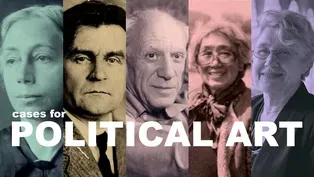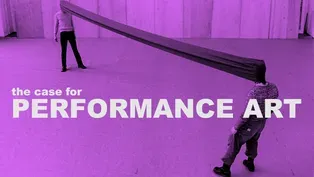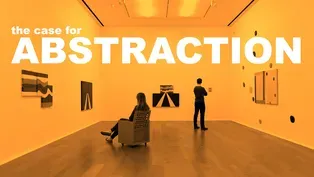
The Case for Jackson Pollock
Season 4 Episode 21 | 10m 30sVideo has Closed Captions
We explore the life, evolution, and legacy of Jackson Pollock.
You’ve heard of Jackson Pollock and know of his infamous “drip paintings,” but what is it that you’re supposed to do when you look at his work today? Why did it cause shockwaves in 1947, and what does it mean now? We explore the life, evolution, and legacy of Jackson Pollock.

The Case for Jackson Pollock
Season 4 Episode 21 | 10m 30sVideo has Closed Captions
You’ve heard of Jackson Pollock and know of his infamous “drip paintings,” but what is it that you’re supposed to do when you look at his work today? Why did it cause shockwaves in 1947, and what does it mean now? We explore the life, evolution, and legacy of Jackson Pollock.
How to Watch The Art Assignment
The Art Assignment is available to stream on pbs.org and the free PBS App, available on iPhone, Apple TV, Android TV, Android smartphones, Amazon Fire TV, Amazon Fire Tablet, Roku, Samsung Smart TV, and Vizio.
Providing Support for PBS.org
Learn Moreabout PBS online sponsorshipMore from This Collection
Video has Closed Captions
What purpose did museums serve? And why does every city have one today? (8m 28s)
Video has Closed Captions
This week we explore some of the most powerful artworks ever made. (12m 7s)
Video has Closed Captions
Ai Weiwei has been called an iconoclast, a radical, a voice for the voiceless... (5m 53s)
Video has Closed Captions
Dubious of performance art? Break into a cold sweat when you realize it’s about to begin? (9m 9s)
Video has Closed Captions
How are we supposed to deal with art completely removed from recognizable objects? (9m 17s)
Providing Support for PBS.org
Learn Moreabout PBS online sponsorship[MUSIC PLAYING] NARRATOR: In 1947, Jackson Pollock started dripping, flinging, scattering, and pouring paint onto canvases spread across the floor.
Some thought it was lunacy, but the most influential voices thought it genius.
That's the legacy that has prevailed.
That's why you've heard of him and see his work in museums.
That's why a single one of his paintings can sell for $50 million.
But when you find yourself in front of one of his paintings now, what do you do with it?
How do you look at this and derive some sort of something from it?
Why does it matter?
And what does it mean now?
This is the case for Jackson Pollock.
Paul Jackson Pollock was born in 1912 in Cody, Wyoming, moved around the southwest with his family, attended high school in Los Angeles, and landed in New York in 1930 to pursue art encouraged by his older brother Charles.
Pollock studied at the Art Students League under American regionalist, Thomas Hart Benton, whose representational style he would go on to react against.
But his rhythmic structure and contrast of light and dark, the young artist internalized.
His eyes were trained on the usual suspects of European modernism, including, of course, Picasso, who Pollock once cursed, saying, "That bastard, he misses nothing!"
He looked to the Mexican muralists, like Jose Clemente Orozco and also David Alfaro Siqueiros whose experimental workshop Pollock joined in 1936.
Siqueiros believed the paintbrush to be an implement of hair and wood in an age of steel and that revolutionary art required new materials like automobile lacquer and paint thinner and innovative techniques like airbrushing, stenciling, flinging paint, and controlled accidents.
Pollock incorporated some of these lessons at that time but drew from many sources.
His southwestern childhood had sparked his interest in Native American art.
He visited MoMA's 1941 show, Indian Art of United States, several times attending a demo of Navajo painting made by dropping colored sand on the ground.
In the early '40s, Pollock was making paintings with imagery derived from mythology and from his knowledge of Yuumei analysis.
The surrealist interest in the unconscious attracted him as well.
And he was certainly familiar with their embrace of automatism or yielding control of the making process to let the unconscious mind hold sway.
So it wasn't like Pollock's drip paintings came out of nowhere.
Others were doing it too.
Arshile Gorky dripped in 1944.
Hans Hoffman did around the same time.
And Pollock was trying it out in his paintings as well.
But his first big break came in 1942 with this kind of work, which was selected for a show at Peggy Guggenheim's gallery, Art of this Century, having been judged by the likes of Piet Mondrian who, having fled Europe during World War II, claimed this was the most interesting work he'd seen in America so far.
Pollock's first solo show garnered much attention.
His pictures described as archaic, tribal, and of elemental power.
Curator James Johnson Sweeney described his talent as volcanic.
It has fire.
It is unpredictable.
It is undisciplined.
What we need is more young men who paint from inner impulsion.
Guggenheim also commissioned this new talent to create a mural for her New York townhouse.
And he produced an epic 19-foot long canvas that cemented his rising star status and gave a glimpse of the rhythmic forms and loose brushwork that would follow.
Pollock's other 1942 break was meeting painter Lee Krasner.
They married in '45 and moved out to Long Island near East Hampton where they set up studios-- hers in the house and his in the barn.
Pollock continued to begin his paintings with totemic and mythological subjects but painted over them with layers so thick that the original forms were mostly indistinguishable.
By '47, Pollock was spreading his canvases on the floor.
Sometimes his initial layer involved brushwork, but successive layers were built up with poured, dripped, and scattered paint, artist oils, enamel house paint, and aluminum radiator paint.
He used sticks, trowels, and palette knives.
Sometimes string, sand, or nails entered the mix.
Narrative content began to disappear until all that was visible was the splatters and skeins of paint we all now think of when we think of Pollock.
The titles dropped away too, and he began to number his paintings like musical compositions.
There was no sketching in advance, but it wasn't just paint flung willy nilly, at least most of the time.
To a considerable degree, he controlled his flow of paint and distribution of color.
He knew what kinds of motions and what tools and paints produce certain results.
He decided what to cover over and what to let show through.
His all-over compositions betray a keen awareness of the edges.
And after jags of activity, he would stop and take stock of what he'd done before entering back in or deciding the work was resolved.
Pollock once responded to a critic's remarks by telegramming Time magazine saying simply, "No chaos damn it."
This new work did have its critics.
It was described as a child's contour map of the Battle of Gettysburg and a mop of tangled hair.
Then and now, people likened his dripping to bodily spillage-- vomit, pee, ejaculate.
But there were many who championed this radical departure, notably the Museum of Modern Art and art critic, Clement Greenberg, who believed Pollock's drip paintings to be the culmination of the advancement of art since the dawn of modernism, charting "the dissolution of the pictorial into sheer texture into apparently sheer sensation."
Pollock became a larger-than-life figure thanks to media attention and the revelatory images made by photographer Hans Namuth of Pollock painting in 1950.
Namath also made a short film of Pollock at work outdoors and gave us the unforgettable view from below of Pollock painting on glass.
Art critic, Harold Rosenberg, called this kind of work action painting.
As Pollock was among a number of artists at the time for whom the canvas could be considered "an arena" in which to act, the term abstract expressionism began to be used to describe the work of these artists who pursued abstraction as a means to convey emotion, each with their own distinctive gesture and approach.
World War II had been hell, and for Pollock and his ilk, still lifes and portraits were now insufficient.
Echoing Siqueiros, Pollock explained new needs need new techniques.
Today, painters do not have to go to a subject matter outside themselves.
They work from a different source.
They work from within.
He had a productive pocket of years and would return to representation with a series of paintings from '51 and '52 made with black enamel and a turkey baster, oscillating between abstraction and figuration.
But in his last years, he made work only sporadically, struggling with the alcoholism that plagued him throughout his life.
Pollock was at the wheel when he died in a car accident in 1956 at the age of 44, throwing his mistress from the car and killing her friend.
Then and now, Pollock's brief but brilliant career was emblematic of the post-war American boom, a country no longer culturally subservient to Europe but defining its own terms.
Pollock symbolized American fearlessness and freedom, so much so that his work and that of his peers was promoted during the Cold War as proof of what was possible in a democracy-- no matter that Pollock had been a member of the Communist Party.
There's a tendency to think of Pollock's breakthrough as cutting the 20th century into halves-- a before and an after.
In 1958, artist Allan Kaprow wrote, "He created some magnificent paintings, but he also destroyed painting."
Of course, he didn't destroy painting.
He destroyed some sense a painting as a grand progression of movements from this to that.
The medium has persisted, finding other innovations and other audiences.
Kaprow saw Pollock's legacy as pointing the way forward from painting to everything else, leaving us "at the point where we must become preoccupied with and even dazzled by the space and objects of our everyday life."
As Pollock reacted against Benton, many artists reacted against Pollock, against gesture, against expression.
As quickly as it appeared, Pollock's signature mark making became clicheed, representing an era in American history when the art was macho and large.
The art world was insular and small.
And the reputed artists were almost all-male and white.
But where does this leave us today?
When looking at his work, Pollock recommended we "not look for but look passively and try to receive what the painting has to offer and not bring a subject matter or preconceived idea to it."
Of course, no one comes to art or to anything this way.
But perhaps you might appreciate the work he suggested "just as music is enjoyed.
After a while, you may like it or you may not."
Ornette Coleman likened his own improvisational jazz to Pollock's work and said, "It's not random.
He knows what he's doing.
He knows when he's finished, but still it's free form."
What happens in the artist studio is almost always a mystery-- training and expertise and persistence synthesized over time into a picture or a thing.
But Pollock shows what happened to get us here more distinctly than anyone had before.
It's clear that a person was here and traversed this canvas.
And now he's not.
Paint that was once liquid and flowing now hardened and frozen in time.
Pollock called it energy and motion made visible and memories arrested in space.
While the largeness of his persona has faded, Pollock certainly isn't absent when you with the work.
It's fun and almost irresistible to imagine being Pollock.
There are lots of things you can think about when looking at this work-- how a lot of painting tries to hide the fact that it is indeed made of a viscous substance while a Pollock allows the pain to revel in its true liquid self.
You can think about how the picture plane is at once shallow and dense and also overwhelmingly expansive, pointing to the infinity that lies beyond.
You can make note of the variety of markings and textures and the tension between planning and accident.
What's the difference really between drawing directly on the canvas or in the space just above it?
Everything and nothing it turns out.
That bit of distance relinquishes authorship and allows gravity and chance and life to play a part.
It's in that distance that we reside when with his work-- in that nebulous area between conscious and unconscious thought and action where so much of life can be found.
These pictures are not easy to read.
There is no beginning and no end really-- an idea Pollock considered a compliment.
In these lines and layers and residues, there is new information blotting out old.
There are vast networks of markings-- what Kaprow called the endless tangle.
Like an ocean or a galaxy, we must settle to a great degree in their inscrutability.
In a similar sense, we must also live with and struggle to grasp as Pollock so desperately did the inscrutability within.

















